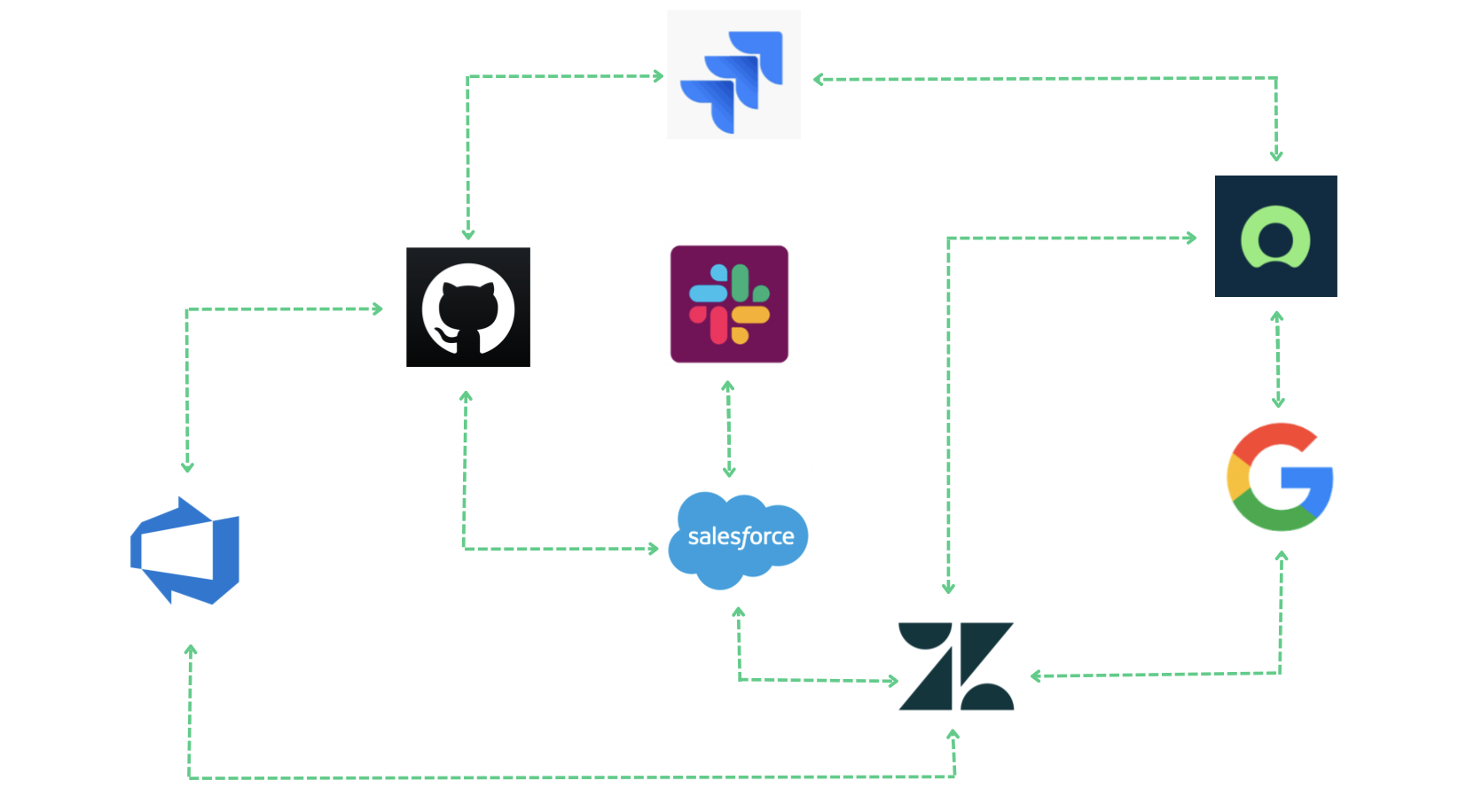APIs (Application Programming Interfaces) are everywhere in today’s digital landscape. We tend to interact with them without even realizing it. For instance, every time we check – the weather or book a flight ticket, we use them behind the scenes. But have you ever wondered how these APIs talk to each other? That’s where API integration comes in.
A common conundrum associated with API integration is the challenge to integrate unique APIs with different data formats and structures. It becomes trickier when businesses evolve in size and need to connect with newer ones.
How then can compatibility and consistency be ensured across integrations, particularly with frequent updates to APIs?
Read on to learn more about API integration, its benefits for businesses, common use cases, selecting the appropriate integration solution, and what an implementation would entail.
An Introduction to API Integration
API integration is vital to businesses today. Chances are, if you have used a 3rd-party application or service, you have already experienced API integration in action.
But before we go any further, let’s take a step back and understand what APIs are in the first place.
Demystifying APIs
During my decade-long career as a software developer, I have frequently encountered the need to explain the concept of APIs to individuals without a technical background. I have come to appreciate the following analogy:
When operating a vehicle, the primary concern is driving. You might not always be well-versed in the intricacies of the engine or the components at play. As a result, any unnecessary information is concealed while you only focus on the task at hand.
The illustration highlights the programming concept of abstraction, where details are concealed to present only the most pertinent information to the driver.

APIs provide an abstraction layer for software applications, providing subroutines, protocols, and tools necessary for their development.
They also set rules for how applications and database servers interact with each other through a request/ response mechanism.
But just like with friends, you have to speak the same language! So you must send a request in a format that the API can understand. If not, it will kindly let you know with an error message.
They are platform-independent. So you can fetch any information from an application without worrying about your technology stack.
APIs offer endpoints. These are URLs you can use to refer to the exposed data.
To maintain security, sometimes APIs may require authentication.
Note: REST (Representational State Transfer) APIs are the most popular architectural style for web-based applications. There are also others like SOAP (Simple Object Access Protocol) and RPC (Remote Procedure Call), not so common.
Many software vendors or providers offer public (or open) APIs that developers can use to access software applications or web services.
But how to connect these APIs that have different formats and structures? How can you innovate faster with APIs? How to ensure communication between proprietary applications reaches new levels of service delivery and achieves flexibility in information exchange?
API integration plays a crucial role in this context.
What is API Integration
Businesses use a lot of applications – SaaS, custom-built, legacy, ERPs, CRMs, etc. Teams using these applications will benefit from working together.

The development team can benefit from inputs given by the support teams. Or they might want to collaborate with the marketing team to create better marketing campaigns.
API integration is the process of connecting multiple APIs. It enables the transfer and synchronization of information for a successful business operation or informed decision-making.
Additionally, it can transform data between two application APIs while maintaining data integrity.
Think about an e-commerce website that automatically integrates with a shipping carrier’s API, calculates shipping rates, and generates shipping labels. The integration can streamline the order fulfillment process and ensure accurate and timely delivery information.
If teams leverage the power of APIs, they can create integrations that are more scalable, flexible, and adaptable to business needs.
Still curious about API integration? Let’s explore this further.
Common API Integration Use Cases
Here are some typical examples of API integration in action.
Payment Gateway Integration
Payment gateway integrations can enable secure verification of credit or debit card details. It can also perform other necessary authentications within your application. Rather than building all this from scratch, you utilize readily available APIs.

Automating the Software Development Workflow
Software development can be a complex process. The developers might need to send issues from Jira (a tool they use) to the QA team for testing, who might use a different tool, like Azure DevOps. Statuses need to be updated automatically when any team makes a transition.
Additionally, they may want to simplify access to the application for the front-end developers without in-depth knowledge of the code.

An API integration can automate the software development process by accessing the APIs, automating tasks, or creating new ones to assist team members.
Connecting with a CRM to Enhance Customer Experience
Salesforce (a CRM) is used to manage customer data and interactions.
Imagine fetching customer details and creating records automatically in your ERP system (e.g. Netsuite) in real time. Further automating this based on preset conditions, for instance, an Opportunity State turns “Won”.

You can create consistent, reliable workflows and improve productivity by integrating your CRM with other apps.
The Benefits of API Integration
API integration allow you to put down manual, repetitive tasks and help avoid mistakes that accompany them.
To put this into perspective, it can
- improve team efficiency since they no longer have to dedicate their productive work hours to copy-pasting or toggling between applications.
- optimize collaboration and communication across teams by connecting diverse APIs to perform a joint function.
- enhance reporting and analysis by extracting relevant data from the desired application. For example, you can use ZenRows’ scraping APIs for that purpose.
- elevate service quality and delivery levels by understanding the needs and expectations of customers. It can help identify areas of improvement, such as response times, communication channels, or product offerings.
- maximize the flexibility of information sharing by integrating APIs into applications and deciding what data to receive or how to manipulate it.
Ready to take your data to the next level? Let’s implement an API integration.
How to Implement an API Integration
Implementing an integration is easier than you think. Is it? Think again.
API Integration Process
In API integration, data is pushed and pulled between applications automatically instead of manually.
So it adds three layers to the APIs you want to integrate:
- Abstraction
- Automation
- Transformation
This is done such that data is
- exchanged based on the conditions you specify (uni or bi-directionally).
- updated or created anew when something changes in one of the applications.
- transformed from one format to another.
There are various ways to integrate APIs, some native, some smart, and others outright complex.

It eventually boils down to your business requirements.
Let’s look at some common ways businesses achieve API integration.
Custom-code to Build an API Integration
So you want to create a custom-made integration for your business. Possible? Yes. Feasible? Not so much.
Firstly, you must create the entire integration layer and then provide automation for exchanging information. It means manual hand-written code for transforming, consolidating, refining, and transferring data from diverse sources or applications. This can take weeks or sometimes months to complete. It also wastes a lot of productive development time and resources.
Secondly, consider that each application has its own set of REST APIs. Developers must ensure that they appropriately map, store, capture, and use different data formats.
Thirdly, you need to maintain the integration yourself – manage the APIs, handle downtimes and errors, enable reporting and monitoring; spend time nurturing it to ensure it works as expected.
Technology develops at the speed of lightning. So does the advancement in the integration construct.
Instead of writing the code yourself, would you prefer someone already did that for you? You can just choose what to send or receive.

In the upcoming section, we discuss 2 other options to get the ball rolling.
Fundamentally, these methods are the same, albeit with a few subtle differences.
Using Native API Integration Capabilities
Software vendors, lately, have acknowledged the need for integration.
So a lot of commercially renowned platforms provide predefined native integrations. These work as middleware that handles the needs of small and large businesses alike.
For instance, with a simple drag-and-drop interface, you can easily integrate popular applications like Jira, Salesforce, Zendesk, ServiceNow, etc.
These native tools connect applications in a point-to-point manner, effectively handling all the complex details for you.
They invoke the necessary APIs. The data is accessed, aggregated, updated, transformed, or exchanged. Therefore, an automation and abstraction layer is in place to facilitate these API calls.
You get an interface to develop your integration flow and decide what data you want to exchange and how you want to exchange it.
But, there is also a flip side to this. Native API integrations are often limited in the functionality they offer.
For instance, they are perfect if you only need to send data in a single direction, from one system to another, but not for complex bi-directional workflow orchestrations. Moreover, it is difficult to incorporate any changes in your integration requirements. Sometimes even a small change can mean you must edit the entire flow.

3rd-party integration tools are the preferred and widely accepted approach to integrating APIs, as they eliminate the need to write code from scratch or constrain your integration options.
Integrating with 3rd-Party API Integration Solutions
Before we examine this further, let’s see why a 3rd-party API integration platform can help you reach maximum integration potential.
These tools have the following significant features:
- They provide pre-built integration templates for various applications but also allow custom integrations.
- They handle multiple data types (JSON, XML, etc) and simplify data mapping, eliminating concerns about data formats and architectures.
- They offer various functions for transforming, consolidating, syncing, mapping, and updating data from APIs.
- They support advanced conditional logic and complex mappings for flexible data exchange.
- They offer a comprehensive API integration and management solution that ensures scalability, data integrity, and automation across your entire technology stack.
- They handle security or other GDPR considerations for data exchange.
Using these tools you can easily implement the following information flow requirements from ServiceNow to Jira:

And have a completely new set of requirements for information flow from Jira to ServiceNow.

As evident, most integration solutions perform the same basic function, and numerous options are available in the market. However, by asking the right questions and selecting a solution that aligns with your specific integration needs, you can reach a decision.
API Integration Tools: Key Questions to Ask
Almost there!
Honestly, there isn’t a right or wrong choice.
It all depends on a few questions you may ask.
- What does the solution primarily do? Is it automation, synchronization, transformation, or real-time data streaming?
- How does the tool ensure security measures are in place?
- What is the pricing model for the API integration service it offers? Is it connector-based with an adaptive price model or a flat rate for unlimited integrations?
- How does the tool handle monitoring and alerts? What happens in case of downtimes or errors? Does the tool crash or resume automatically without manual intervention?
- Does the tool handle advanced API-based data integration requirements with ease? Does it offer a diverse range of use cases while reducing implementation efforts?
- Is the tool future-proof and flexible enough to accommodate inevitable changes in an integration requirement?
- …
And the final question remains. How do I know the right one?
Choosing the Right API Integration Solution for Your Needs
API automation platforms like Zapier, a flow-based solution, are designed to automate repetitive tasks, saving time and increasing efficiency. It can trigger an action in one application based on an event in another application.
But it’s not suitable for ongoing bi-directional API integrations between applications. Also, after a point, its flows are limited, inflexible, and time-consuming to maintain.
Exalate is an API integration solution with a built-in scripting engine.

It can perform the following tasks:
- Abstract, automate, transform, and manage the underlying APIs.
- Allow users to implement complex integration use cases without constantly focusing on the API structure.
- Offer two modes: a no-code mode and a script mode, making it accessible for both technical and non-technical teams.
- Provides the option to offload your entire integration hassle to us with the integration as a service offering.
A scalable and adaptable integration solution handles a variety of use cases. It is also flexible enough to adapt to changing future business needs and technology. Such solutions can minimize the implementation effort and maintenance.
Exalate strives to achieve this intricate balance.
Honestly, there isn’t a one-size-fits-all answer to the question. There are always solutions that work the best for particular requirements and ones that don’t.
The questions we posed may serve as a useful starting point, but there is still much more to be accomplished.
The integration of an API is a project in its own, encompassing all necessary stages from planning and requirement gathering to implementation and ongoing maintenance.
Conclusion
As technology evolves, APIs will play a crucial role in shaping the future of software development.
In this blog post, we saw how integrating APIs can bring significant benefits like – improved user experience and reduced development cost and effort.
However, successful integration requires careful planning and consideration of factors such as API compatibility, security, and scalability.
We discussed how API integration solutions leverage these APIs and can set up advanced integrations in a simple and flexible manner. They can help you stay ahead of the curve and build applications of tomorrow.
Frequently Asked Questions
What is an API?
API stands for “Application Programming Interface.” It is a set of rules and protocols that allows different software applications to communicate and interact with each other, enabling them to access and exchange data or functionalities.
What is API integration?
API integration is the process of connecting and enabling communication between different software systems or applications using their APIs, allowing them to share data and functionalities seamlessly.
Why should I integrate APIs?
Integrating APIs allows you to leverage the capabilities of other software systems, access valuable data, and extend functionalities, resulting in improved efficiency, enhanced user experiences, and the ability to create innovative solutions faster and more cost-effectively.
What are API integration examples?
API integration examples include:
- Integrating payment gateways into an e-commerce website to process transactions securely.
- Integrating Google Maps API to display location-based information on a website or application.
- Connecting CRM APIs with marketing automation tools for seamless data synchronization.
- Integrating messaging APIs to enable real-time communication between users in an application.
- Automating the software development workflow across multiple applications like Jira, Azure DevOps, etc.
How to implement API integration?
You can implement an API integration either by custom building an API integration in-house or by using native API connector applications. However, both these approaches lack customization, scalability, and flexibility. Integrating with third-party integration solutions like Exalate can help you reach maximum integration excellence while still maintaining the required flexibility and scalability.
Recommended Reads:
- Integration as a Service (IaaS): Everything Explained
- The Comprehensive Guide to iPaas (Integration Platform as a Service)
- B2B Integration: The Comprehensive Guide
- eBonding Integration: The Ultimate Guide to Flexible Data Sync
- Service Integration and Management: an Introduction to SIAM
- How to Build an Effective SIAM Operating Model
- CISCO Smart Bonding: An Introduction




